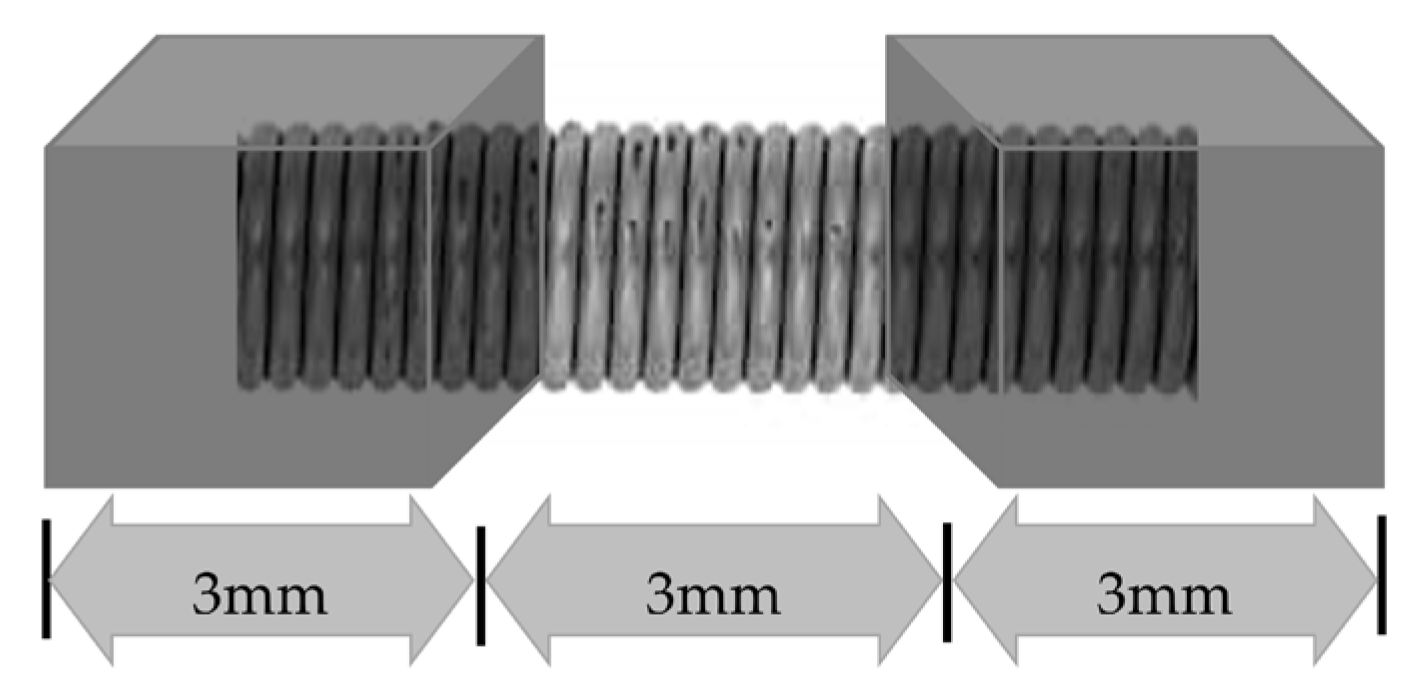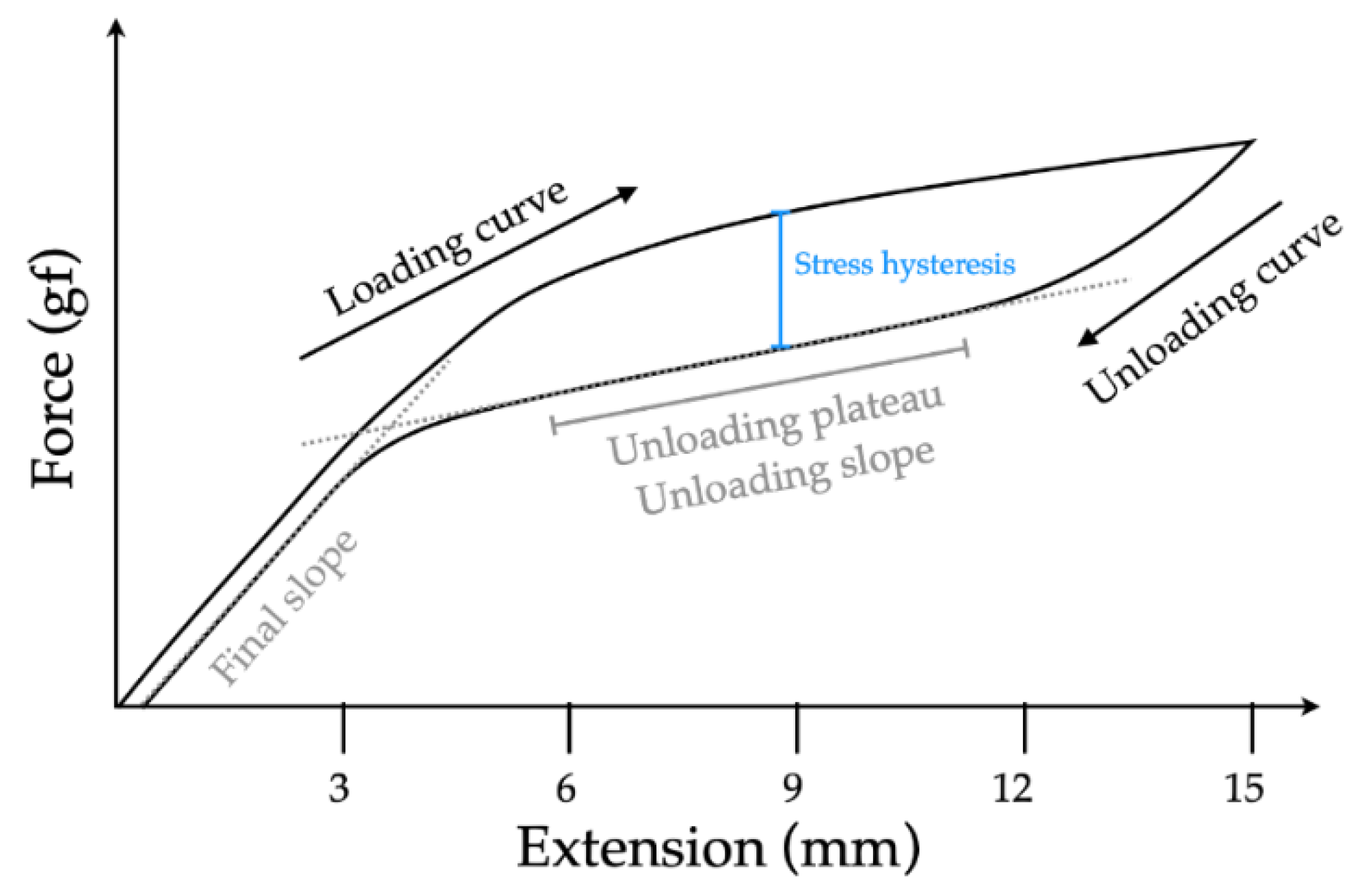The Effects of Temperature and Time of Heat Treatment on Thermo-Mechanical Properties of Custom-Made NiTi Orthodontic Closed Coil Springs
Abstract
1. Introduction
2. Materials and Methods
2.1. Fabrication of NiTi Closed Coil Springs
2.2. Electron Probe Micro-Analysis (EPMA)
2.3. Differential Scanning Calorimeter (DSC)
2.4. Tensile Tests
2.5. Data Analysis
3. Results
3.1. Composition of NiTi Materials
3.2. Transformation Temperature Range (TTR)
3.3. Mechanical Properties: Force Delivery, Plateau Slope, SE Ratio, and Stress Hysteresis
3.3.1. Force Delivery
3.3.2. Plateau Slope, SE Ratio, and Stress Hysteresis
4. Discussion
5. Conclusions
Author Contributions
Funding
Institutional Review Board Statement
Informed Consent Statement
Data Availability Statement
Acknowledgments
Conflicts of Interest
References
- Miura, F.; Mogi, M.; Ohura, Y.; Hamanaka, H. The super-elastic property of the Japanese NiTi alloy wire for use in orthodontics. Am. J. Orthod. Dentofac. Orthop. 1986, 90, 1–10. [Google Scholar] [CrossRef]
- Miura, F.; Mogi, M.; Ohura, Y.; Karibe, M. The super-elastic Japanese NiTi alloy wire for use in orthodontics. Part III. Studies on the Japanese NiTi alloy coil springs. Am. J. Orthod. Dentofac. Orthop. 1988, 94, 89–96. [Google Scholar] [CrossRef]
- Ren, Y.; Maltha, J.C.; Kuijpers-Jagtman, A.M. Optimum force magnitude for orthodontic tooth movement: A systematic literature review. Angle Orthod. 2003, 73, 86–92. [Google Scholar] [CrossRef]
- Halimi, A.; Benyahia, H.; Doukkali, A.; Azeroual, M.-F.; Zaoui, F. A systematic review of force decay in orthodontic elastomeric power chains. Int. Orthod. 2012, 10, 223–240. [Google Scholar] [CrossRef] [PubMed]
- Santos, A.C.; Tortamano, A.; Naccarato, S.R.; Dominguez-Rodriguez, G.C.; Vigorito, J.W. An in vitro comparison of the force decay generated by different commercially available elastomeric chains and NiTi closed coil springs. Braz. Oral Res. 2007, 21, 51–57. [Google Scholar] [CrossRef] [PubMed]
- Segner, D.; Ibe, D. Properties of superelastic wires and their relevance to orthodontic treatment. Eur. J. Orthod. 1995, 17, 395–402. [Google Scholar] [CrossRef] [PubMed]
- Ohara, A.T. Clinical importance of austenitic final point in the selection of nickel-titanium alloys for application in orthodontic-use arches. Rev. Odontol. Mex. 2016, 20, e162–e169. [Google Scholar] [CrossRef]
- Copelovici, N.; Tran, M.; Lefebvre, F.; Laheurte, P.; Wagner, D. Super-elasticity in vitro assessment of CuNiTi wires according to their Austenite finish temperature and the imposed displacement. Angle Orthod. 2022, 92, 388–395. [Google Scholar] [CrossRef] [PubMed]
- Geng, H.; Su, H.; Whitley, J.; Lin, F.C.; Xu, X.; Ko, C.C. The effect of orthodontic clinical use on the mechanical characteristics of nickel-titanium closed-coil springs. J. Int. Med. Res. 2019, 47, 803–814. [Google Scholar] [CrossRef] [PubMed]
- Fernandes, D.J.; Peres, R.V.; Mendes, A.M.; Elias, C.N. Understanding the shape-memory alloys used in orthodontics. ISRN Dent. 2011, 2011, 132408. [Google Scholar] [CrossRef] [PubMed]
- Savi, M.A.; Paiva, A.; de Araujo, C.J.; de Paula, A.S. Shape Memory Alloys. In Dynamics of Smart Systems and Structures; Lopes, V., Jr., Steffen, V., Jr., Savi, M., Eds.; Springer: Cham, Switzerland, 2016; pp. 155–188. [Google Scholar] [CrossRef]
- O’Brien, B.; Weafer, F.M.; Bruzzi, M.S. 1.3 Shape Memory Alloys for Use in Medicine. In Comprehensive Biomaterials II; Ducheyne, P., Ed.; Elsevier: Oxford, UK, 2017; pp. 50–78. [Google Scholar] [CrossRef]
- Santoro, M.; Nicolay, O.F.; Cangialosi, T.J. Pseudoelasticity and thermoelasticity of nickel-titanium alloys: A clinically oriented review. Part II: Deactivation forces. Am. J. Orthod. Dentofac. Orthop. 2001, 119, 594–603. [Google Scholar] [CrossRef] [PubMed]
- Abdullah, S.S.; Taha, J.H. Effect of Annealing on the Transformation Behavior of NiTi Shape Memory Alloy. In Proceedings of the 12th International Conference on Developments in eSystems Engineering (DeSE), Kazan, Russia, 7–10 October 2019; pp. 518–521. [Google Scholar]
- Pelton, A.R.; Russell, S.M.; DiCello, J. The physical metallurgy of nitinol for medical applications. JOM 2003, 55, 33–37. [Google Scholar] [CrossRef]
- Vieira, C.I.; Caldas, S.G.; Martins, L.P.; Martins, R.P. Superelasticity and force plateau of nickel-titanium springs: An in vitro study. Dent. Press J. Orthod. 2016, 21, 46–55. [Google Scholar] [CrossRef] [PubMed][Green Version]
- Ishii, T. Design of Shape Memory Alloy (SMA) Coil Springs for Actuator Applications. In Shape Memory and Superelastic Alloys-Technologies and Applications; Woodhead Publishing: Sawston, UK, 2011. [Google Scholar]
- Brantley, W.A. Evolution, clinical applications, and prospects of nickel-titanium alloys for orthodontic purposes. J. World Fed. Orthod. 2020, 9, S19–S26. [Google Scholar] [CrossRef]
- Wen, S.; Gan, J.; Li, F.; Zhou, Y.; Yan, C.; Shi, Y. Research status and prospect of additive manufactured nickel-titanium shape memory alloys. Materials 2021, 14, 4496. [Google Scholar] [CrossRef]
- Abujudom, D.N.; Thoma, P.E.; Fariabi, S. The effect of cold work and heat treatment on the phase transformations of near equiatomic NiTi shape memory alloy. Mater. Sci. Forum 1990, 56–58, 565–570. [Google Scholar] [CrossRef]
- Noonoi, N.; Khantachawana, A.; Kaewtathip, P.; Kajornchaiyakul, J. Influences of Reduction Ratio on Mechanical Properties and Transformation Temperature of NiTi Drawn Wires. In Proceedings of the Second TSME International Conference on Mechanical Engineering, Krabi, Thailand, 19–21 October 2011. [Google Scholar]
- Mitwally, M.E.; Farag, M. Effect of cold work and annealing on the structure and characteristics of NiTi alloy. Mater. Sci. Eng. A 2009, 519, 155–166. [Google Scholar] [CrossRef]
- Drexel, M.; Selvaduray, G.; Pelton, A. The Effects of Cold Work and Heat Treatment on the Properties of Nitinol Wire. In Proceedings of the 2nd Frontiers in Biomedical Devices Conference, Irvine, CA, USA, 7–8 June 2007. [Google Scholar] [CrossRef]
- Vojtech, D. Influence of Heat Treatment of Shape Memory NiTi Alloy on Its Mechanical Properties. In Proceedings of the METAL 2010—19th International Conference on Metallurgy and Materials, Roznov pod Radhostem, Czech Republic, 18–20 May 2010; pp. 867–871. [Google Scholar]
- Nishida, M.; Wayman, C.M.; Honma, T. Precipitation processes in near-equiatomic TiNi shape memory alloys. Metall. Trans. A 1986, 17, 1505–1515. [Google Scholar] [CrossRef]
- Bezrouk, A.; Balsky, L.; Smutny, M.; Selke Krulichova, I.; Zahora, J.; Hanus, J.; Meling, T.R. Thermomechanical properties of nickel-titanium closed-coil springs and their implications for clinical practice. Am. J. Orthod. Dentofac. Orthop. 2014, 146, 319–327. [Google Scholar] [CrossRef]
- Barras, C.D.; Myers, K.A. Nitinol—Its use in vascular surgery and other applications. Eur. J. Vasc. Endovasc. Surg. 2000, 19, 564–569. [Google Scholar] [CrossRef] [PubMed]
- Gil, F.J.; Solano, E.; Peña, J.; Engel, E.; Mendoza, A.; Planell, J.A. Microstructural, mechanical and citotoxicity evaluation of different NiTi and NiTiCu shape memory alloys. J. Mater. Sci. Mater. Med. 2004, 15, 1181–1185. [Google Scholar] [CrossRef] [PubMed]
- Shi, X.B.; Guo, F.M.; Zhang, J.S.; Ding, H.L.; Cui, L.S. Grain size effect on stress hysteresis of nanocrystalline NiTi alloys. J. Alloys Compd. 2016, 688, 62–68. [Google Scholar] [CrossRef]
- Lee, B.W. Relationship between tooth-movement rate and estimated pressure applied. J. Dent. Res. 1965, 44, 1053. [Google Scholar] [CrossRef] [PubMed]
- Boester, C.H.; Johnston, L.E. A clinical investigation of the concepts of differential and optimal force in canine retraction. Angle Orthod. 1974, 44, 113–119. [Google Scholar] [CrossRef]
- Iwasaki, L.R.; Liu, Y.; Liu, H.; Nickel, J.C. Speed of human tooth movement in growers and non-growers: Selection of applied stress matters. Orthod. Craniofac. Res. 2017, 20, 63–67. [Google Scholar] [CrossRef] [PubMed]
- Singh, R.; Jayaprakash, P.K.; Yadav, A.; Dawar, M.; Grewal, H.; Mishra, A. Evaluation of levels of interleukin-1b, intensity of pain and tooth movement during canine retraction using different magnitudes of continuous orthodontic force. J. Fam. Med. Prim. Care 2019, 8, 2373–2377. [Google Scholar] [CrossRef]
- Abdul Wahab, R.M.; Abu Kasim, N.; Senafi, S.; Jemain, A.A.; Zainol Abidin, I.Z.; Shahidan, M.A.; Zainal Ariffin, S.H. Enzyme activity profiles and ELISA analysis of biomarkers from human saliva and gingival crevicular fluid during orthodontic tooth movement using self-ligating brackets. Oral Health Dent. Manag. 2014, 13, 194–199. [Google Scholar] [PubMed]
- Močnik, P.; Kosec, T.A. Critical appraisal of the use and properties of nickel–titanium dental alloys. Materials 2021, 14, 7859. [Google Scholar] [CrossRef] [PubMed]






| Sample | Percentage by Atomic Weight | |
|---|---|---|
| Ni | Ti | |
| Custom-made NiTi | 50.57 ± 0.22 | 49.41 ± 0.21 |
| TOMY® | 51.64 ± 0.27 | 48.33 ± 0.27 |
| Heat Treatment Condition (°C, min) | Mf (°C) | Ms (°C) | RMf (°C) | RMs (°C) | RAs (°C) | RAf (°C) | As (°C) | Af (°C) |
|---|---|---|---|---|---|---|---|---|
| 400, 20 | −56.17 | −16.50 | 19.83 | 53.50 | 29.70 | 54.00 | - | - |
| 400, 40 | −57.33 | −13.33 | 24.33 | 58.50 | 29.33 | 59.16 | - | - |
| 400, 60 | −54.00 | −14.00 | 30.00 | 59.16 | 32.50 | 60.67 | - | - |
| 450, 20 | −52.50 | −13.50 | 25.00 | 39.16 | 30.83 | 43.33 | - | - |
| 450, 40 | −54.83 | −13.50 | 25.00 | 35.83 | 29.33 | 38.67 | - | - |
| 450, 60 | −56.5 | −0.66 | 32.5 | 47.00 | 36.33 | 49.33 | - | - |
| 500, 20 | −53.17 | −13.00 | 10.00 | 17.17 | 0.00 | 12.33 | 15.50 | 20.33 |
| 500, 40 | - | −47.67 | 14.00 | 19.17 | 4.00 | 17.17 | 19.17 | 23.00 |
| 500, 60 | - | −42.17 | 16.00 | 21.67 | 7.83 | 21.17 | 22.67 | 26.33 |
| TOMY® | −56.17 | −25.67 | 16.67 | 37.33 | - | - | 14.83 | 31.33 |
| Conditions (°C, min) | Plateau Slope | SE Ratio | Stress Hysteresis (gf ± S.D.) | ||
|---|---|---|---|---|---|
| 6 mm | 9 mm | 12 mm | |||
| 400, 20 | 5.11 | 2.76 | 26.77 ± 4.25 | 33.59 ± 4.00 | 30.49 ± 3.35 |
| 400, 40 | 5.54 | 2.09 | 26.19 ± 7.01 | 31.37 ± 4.25 | 25.28 ± 5.00 |
| 400, 60 | 5.67 | 2.50 | 24.93 ± 3.74 | 33.97 ± 3.67 | 30.02 ± 2.81 |
| 450, 20 | 5.10 | 3.06 | 17.10 ± 2.22 | 28.50 ± 2.03 | 26.83 ± 0.58 |
| 450, 40 | 4.21 | 3.87 | 23.71 ± 2.98 | 33.74 ± 2.98 | 30.32 ± 2.91 |
| 450, 60 | 4.27 | 3.63 | 25.46 ± 3.43 | 35.42 ± 2.77 | 31.01 ± 1.19 |
| 500, 20 | 3.44 | 5.63 | 26.15 ± 3.43 | 31.31 ± 2.31 | 27.74 ± 3.38 |
| 500, 40 | 2.88 | 8.06 | 32.68 ± 3.57 | 36.82 ± 4.89 | 31.83 ± 3.67 |
| 500, 60 | 3.08 | 6.61 | 32.91 ± 7.96 | 38.61 ± 7.34 | 33.44 ± 4.25 |
| TOMY® | 2.76 | 13.79 | 55.12 ± 2.55 | 55.47 ± 2.68 | 41.65 ± 3.33 |
Publisher’s Note: MDPI stays neutral with regard to jurisdictional claims in published maps and institutional affiliations. |
© 2022 by the authors. Licensee MDPI, Basel, Switzerland. This article is an open access article distributed under the terms and conditions of the Creative Commons Attribution (CC BY) license (https://creativecommons.org/licenses/by/4.0/).
Share and Cite
Assawakawintip, T.; Santiwong, P.; Khantachawana, A.; Sipiyaruk, K.; Chintavalakorn, R. The Effects of Temperature and Time of Heat Treatment on Thermo-Mechanical Properties of Custom-Made NiTi Orthodontic Closed Coil Springs. Materials 2022, 15, 3121. https://doi.org/10.3390/ma15093121
Assawakawintip T, Santiwong P, Khantachawana A, Sipiyaruk K, Chintavalakorn R. The Effects of Temperature and Time of Heat Treatment on Thermo-Mechanical Properties of Custom-Made NiTi Orthodontic Closed Coil Springs. Materials. 2022; 15(9):3121. https://doi.org/10.3390/ma15093121
Chicago/Turabian StyleAssawakawintip, Thanate, Peerapong Santiwong, Anak Khantachawana, Kawin Sipiyaruk, and Rochaya Chintavalakorn. 2022. "The Effects of Temperature and Time of Heat Treatment on Thermo-Mechanical Properties of Custom-Made NiTi Orthodontic Closed Coil Springs" Materials 15, no. 9: 3121. https://doi.org/10.3390/ma15093121
APA StyleAssawakawintip, T., Santiwong, P., Khantachawana, A., Sipiyaruk, K., & Chintavalakorn, R. (2022). The Effects of Temperature and Time of Heat Treatment on Thermo-Mechanical Properties of Custom-Made NiTi Orthodontic Closed Coil Springs. Materials, 15(9), 3121. https://doi.org/10.3390/ma15093121






